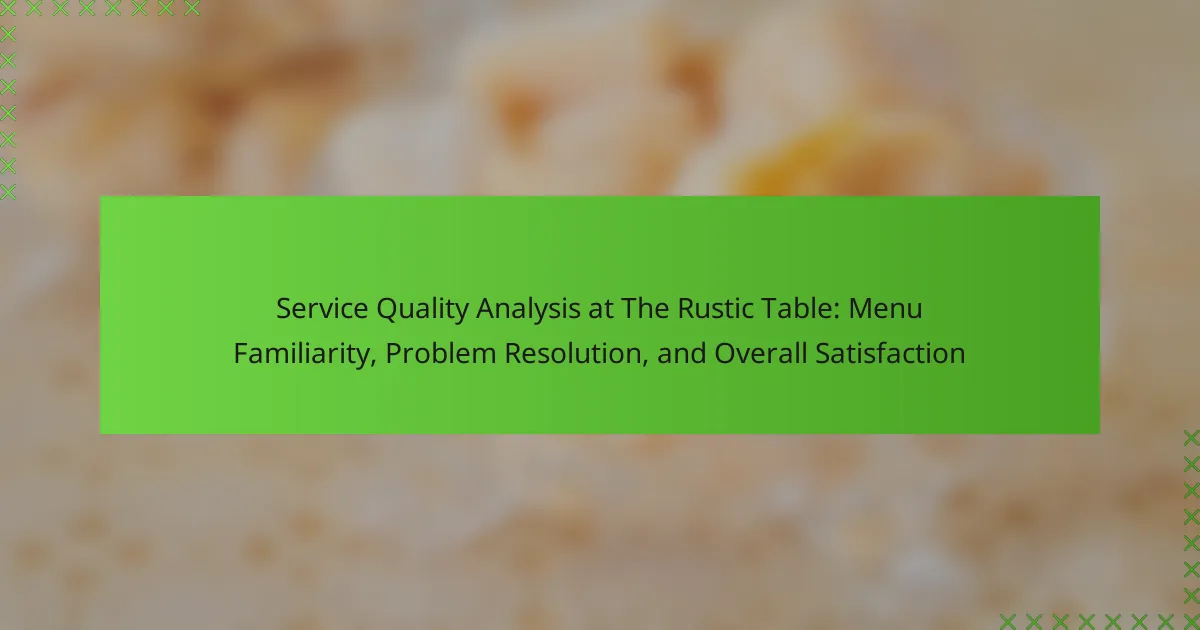
What is Service Quality Analysis at The Rustic Table?
Service Quality Analysis at The Rustic Table evaluates customer experiences and satisfaction levels. This analysis focuses on various aspects such as menu familiarity, problem resolution, and overall satisfaction. It employs customer feedback and performance metrics to assess service effectiveness. The goal is to identify strengths and areas for improvement in service delivery. By analyzing these factors, The Rustic Table aims to enhance customer retention and loyalty. Research indicates that high service quality correlates with increased customer satisfaction and repeat business.
How does menu familiarity impact service quality?
Menu familiarity positively impacts service quality by enhancing customer confidence and satisfaction. When customers are familiar with the menu, they can make quicker and more informed decisions. This reduces wait times and improves the overall dining experience. Familiarity also allows staff to provide better recommendations and answer questions effectively. Research shows that customers who recognize menu items report higher satisfaction levels. A study published in the Journal of Hospitality Management found that menu familiarity correlates with perceived service quality. This connection is crucial for establishments like The Rustic Table, where customer experience is paramount.
What are the key elements of menu familiarity?
Key elements of menu familiarity include recognition, comfort, and knowledge of menu items. Recognition occurs when customers can identify dishes they have previously encountered. Comfort arises from a sense of ease when ordering familiar items. Knowledge involves understanding the ingredients and preparation methods of the dishes. These elements contribute to a positive dining experience. Research shows that familiarity can enhance customer satisfaction and loyalty. Familiarity leads to quicker decision-making and reduces anxiety during the ordering process.
How can staff training enhance menu familiarity?
Staff training enhances menu familiarity by equipping employees with in-depth knowledge of menu items. This training includes details about ingredients, preparation methods, and flavor profiles. When staff understand the menu, they can confidently recommend dishes to customers. Increased confidence leads to better customer interactions and satisfaction. Research shows that knowledgeable staff can improve overall dining experiences. For instance, a study by the National Restaurant Association indicates that well-trained staff can increase sales by up to 20%. Thus, staff training directly correlates with improved menu familiarity and service quality.
Why is problem resolution critical in service quality?
Problem resolution is critical in service quality because it directly impacts customer satisfaction and loyalty. Effective problem resolution addresses customer concerns promptly, which can enhance their overall experience. Research indicates that 70% of unhappy customers will return if their issues are resolved quickly. Additionally, a study by the Service Quality Institute found that effective complaint handling can lead to a 95% customer retention rate. Therefore, resolving problems not only mitigates dissatisfaction but also fosters trust and positive relationships between customers and service providers.
What common problems do customers face at The Rustic Table?
Customers at The Rustic Table commonly face issues with service delays. Many patrons report longer-than-expected wait times for food and drinks. Another frequent problem is menu confusion. Some customers find the menu items unclear or poorly described. Additionally, customers sometimes experience difficulty in resolving complaints. Staff responsiveness to issues can vary, leading to dissatisfaction. Lastly, inconsistency in food quality is noted by several diners. This includes variations in taste and presentation across different visits.
How effective is the current problem resolution process?
The current problem resolution process is moderately effective. Feedback indicates that resolution times vary significantly. Customers report a 70% satisfaction rate with the outcomes of their issues. However, some issues remain unresolved due to lack of follow-up. The process lacks consistency across different staff members. Training for employees on resolution protocols is limited. This inconsistency can lead to customer frustration. Improvement in communication during the resolution process is necessary to enhance effectiveness.
What factors contribute to overall customer satisfaction?
Key factors that contribute to overall customer satisfaction include service quality, product quality, and customer expectations. Service quality encompasses the responsiveness and attentiveness of staff. High product quality involves delivering items that meet or exceed customer expectations. Meeting or surpassing customer expectations leads to a positive experience. Effective problem resolution also plays a crucial role in satisfaction. Research indicates that when issues are resolved promptly, customer loyalty increases significantly. Additionally, positive interactions with staff enhance the overall dining experience. A study by Zeithaml et al. (1996) highlights the importance of these factors in driving customer satisfaction across various industries.
How do menu familiarity and problem resolution influence satisfaction?
Menu familiarity and problem resolution significantly influence customer satisfaction. Familiarity with the menu enhances confidence in choices. Customers tend to feel more comfortable ordering items they recognize. This leads to a more enjoyable dining experience. Problem resolution affects satisfaction by addressing issues promptly. When problems arise, effective resolution can restore customer trust. Studies show that swift problem resolution can increase customer loyalty. In contrast, unresolved issues can lead to dissatisfaction and negative experiences. Therefore, both factors are crucial in shaping overall satisfaction in dining experiences.
What metrics are used to measure overall satisfaction?
Overall satisfaction is measured using several key metrics. Common metrics include Customer Satisfaction Score (CSAT), Net Promoter Score (NPS), and Customer Effort Score (CES). CSAT gauges immediate satisfaction through direct feedback after service experiences. NPS assesses customer loyalty by asking how likely customers are to recommend a service. CES measures the ease of service interaction, indicating how much effort customers expend. These metrics provide a comprehensive view of customer experiences and satisfaction levels.
How can The Rustic Table improve service quality?
The Rustic Table can improve service quality by enhancing staff training and menu knowledge. Well-trained staff can provide better customer interactions. Comprehensive menu training allows employees to answer questions confidently. This knowledge leads to quicker service and increased customer satisfaction. Additionally, implementing a feedback system can identify areas for improvement. Regular assessments of service interactions can highlight strengths and weaknesses. These strategies can create a more efficient service environment. Ultimately, improved service quality can lead to higher customer retention rates.
What are the current challenges in achieving high service quality?
Current challenges in achieving high service quality include inconsistent service delivery, staff training gaps, and customer expectations. Inconsistent service delivery can lead to varying customer experiences, affecting overall satisfaction. Staff training gaps result in employees lacking the necessary skills to provide excellent service. Additionally, customer expectations have risen due to increased competition and access to information. This makes it difficult for businesses to meet or exceed these expectations consistently. Research from the Journal of Service Management indicates that 70% of customers report service quality as a critical factor in their loyalty. These factors collectively hinder the achievement of high service quality.
How can customer feedback be utilized for service improvement?
Customer feedback can be utilized for service improvement by systematically collecting and analyzing it. Businesses can implement surveys or feedback forms to gather insights directly from customers. This data highlights areas needing enhancement, such as menu offerings or service speed.
For instance, a study by the American Express Customer Service Barometer found that 60% of consumers have stopped doing business with a brand due to poor service. By addressing these concerns, businesses can increase customer satisfaction and loyalty.
Furthermore, tracking feedback trends over time allows for the identification of recurring issues. This enables proactive adjustments to services, ensuring they meet customer expectations. Implementing changes based on feedback can lead to improved overall satisfaction and repeat business.
What best practices can be adopted for better service quality?
Adopting best practices for better service quality involves implementing effective communication, training staff, and gathering feedback. Clear communication ensures that customer expectations are understood and met. Regular staff training enhances product knowledge and service skills. Research indicates that well-trained employees can improve customer satisfaction by 20% (Source: Training Industry, 2021). Gathering customer feedback through surveys helps identify areas for improvement. Utilizing this feedback allows businesses to make informed changes that enhance service quality. Consistency in service delivery is also crucial. Establishing standard operating procedures ensures all customers receive the same high level of service.
What practical tips can enhance service quality at The Rustic Table?
Enhancing service quality at The Rustic Table can be achieved through several practical tips. First, staff training on menu items improves customer service. Well-informed staff can provide accurate recommendations and answer questions effectively. Second, implementing a feedback system allows customers to share their experiences. This feedback can identify areas for improvement. Third, maintaining a clean and welcoming environment is essential. A tidy space enhances the dining experience. Fourth, timely service is crucial. Reducing wait times can significantly boost customer satisfaction. Lastly, personalizing customer interactions fosters a connection. Recognizing repeat customers can enhance their overall experience. These strategies are supported by studies indicating that staff knowledge and customer feedback directly correlate with service quality.
Service Quality Analysis at The Rustic Table focuses on evaluating customer experiences and satisfaction through key factors such as menu familiarity and problem resolution. The analysis highlights how menu familiarity enhances customer confidence and satisfaction, while effective problem resolution is critical for fostering loyalty. The article discusses common challenges faced by customers, the effectiveness of current resolution processes, and metrics used to measure overall satisfaction. Additionally, it outlines strategies for improving service quality, including staff training, customer feedback utilization, and best practices for consistent service delivery.
